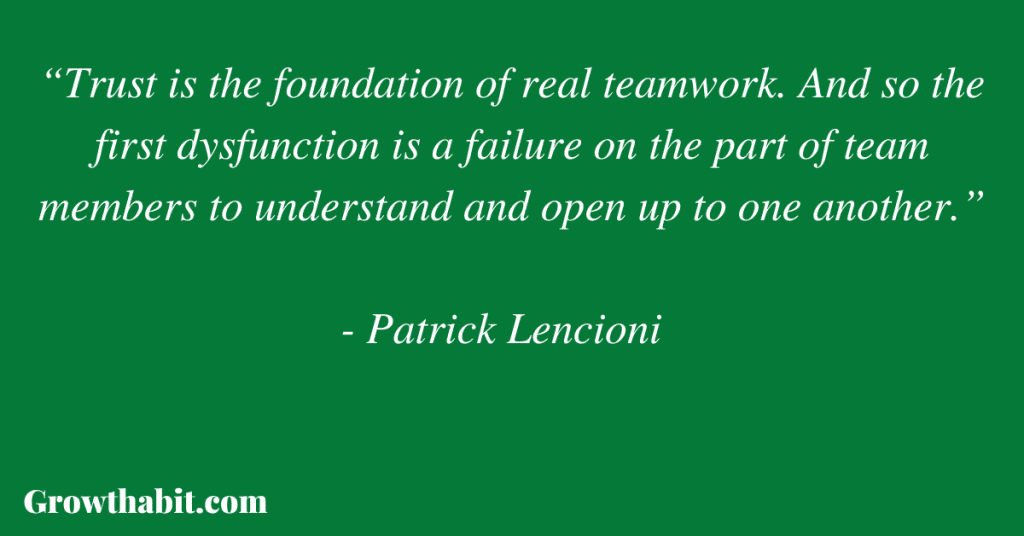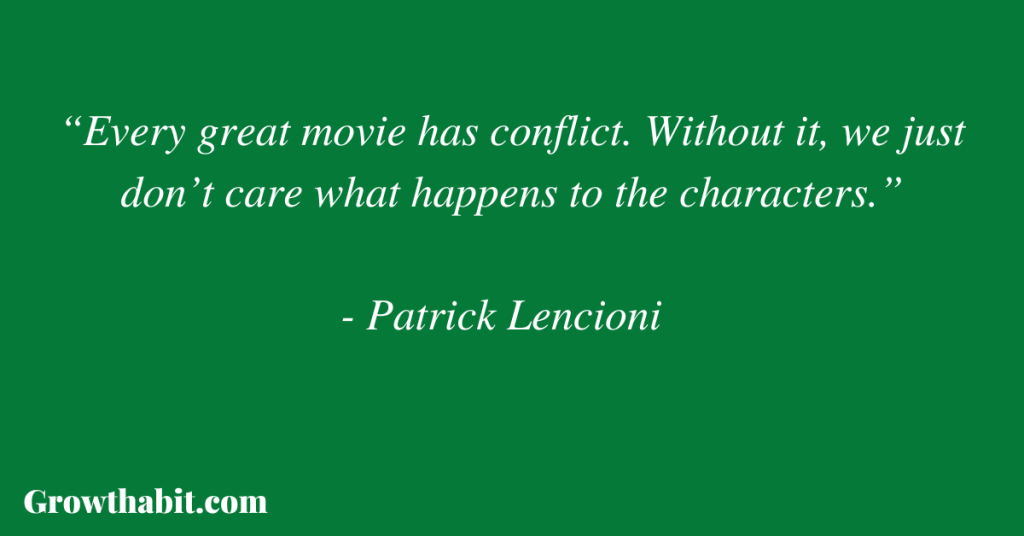The Five Dysfunctions of a Team by Patrick Lencioni is a book that helps struggling teams perform better. In it, Lencioni points out the five main dysfunctions that every team faces at one point and provides solutions to them. The dysfunctions are absence of trust, fear of conflict, lack of commitment, avoidance of accountability, and inattention to results.
Book Title: The Five Dysfunctions of a Team, A Leadership Fable
Author: Patrick Lencioni
Date of Reading: Apr 2023
Rating: 10/10
What Is Being Said In Detail
This book discusses how teams work. With multiple individuals who differ from each other in their personalities, sometimes they may not find the same path to follow.
While introducing us to the dysfunctions, the writer weaves in important questions that are worth considering if you are a part of a team.
A valuable lesson you take after reading the book is that changes do not come overnight and to make them happen, hard decisions must be made.
INTRODUCTION
The introduction points out the importance of teamwork and how simple but painful it can be to achieve good teamwork in your team. It tells us what to expect from the pages we’re about to read and how the idea of writing this book came along.
CHAPTER ONE – The Fable
Chapter 1 is divided into a few pieces that round up the start situation of the DecisionTech company.
Luck
We are introduced to Kathryn Petersen, and her decision of taking into her hands the reins of a company that was promising a lot just two years ago, not knowing what she was getting herself into.
Part One: Underachievement
We get a background story of the DecisionTech company and the removal of its CEO, Jeff Shanley. Here, we meet Kathryn, a 57 years old woman, an old school executive who’s invited to become the new CEO. Even though she was surprised, she accepted the offer.
During the first few weeks, she closely observed the situation and didn’t do much. The rest of the executive team is briefly described, each person being unique in their way.
Part Two: Lighting the Fire
This part is fairly the most intensive part of the book, since everything starts to change. Kathryn puts on the table the concept of the five dysfunctions of the team, making it clear that they had every single one of them.
Absence of trust and inattention to results were the first ones described, as they cover the bottom and the top of the pyramid of the concept. The new CEO ran into resistance at first, but as time passed by, the team progressively got on board with the points Kathryn had.
Part Three: Heavy Lifting
With the new concept introduced, changes were inevitable when it comes to team members. After working together for a while, Kathryn had to approach some of them with a very hard decision in mind.
The team lost two members due to their resistance to adjusting to the mood of an entire team.
Part Four: Traction
Getting to this part, you can notice the improvement in the company. The team was way better than before and to function even better, Kathryn reorganizes the team structure.
What also showed the improvement was their will to keep the company in their own hands once the CEO announced that another company wanted to buy them for a solid price.
CHAPTER TWO – The Model
Chapter 2 is split into three parts for a better understanding of this concept.
An Overview of the Model
Throughout this part, each dysfunction is briefly described one more time to make sure the reader understands what every single one of them means.
Team Assessment
Team assessment offers the reader a simple test. The test helps every leader or member of a team to figure out which dysfunction they have to work on.
Understanding and Overcoming the Five Dysfunctions
For an even better understanding, the writer goes deeper into each dysfunction mentioned. This part is oriented to details and suggestions for overcoming them. Humans are imperfect but members of functional teams do not neglect it, they rather strive to improve each day.
Most Important Keywords, Sentences, Quotes
INTRODUCTION
„It is teamwork that remains the ultimate competitive advantage, both because it is so powerful and so rare.”

“I have found that this allows readers to learn more effectively by losing themselves in a story and by being able to relate to the characters.”
CHAPTER ONE – The Fable
Luck
“She could not have known just how far from grace the company had fallen in such a short period of time, and what the next few months had in store for her.”
Part One: Underachievement
„It had the most experienced—and expensive—executive team imaginable, a seemingly indestructible business plan, and more top-tier investors than any young company could hope for.”
“Backstabbing among the executives had become an art. There was no sense of unity or camaraderie on the team, which translated into a muted level of commitment.”
“And while the Chairman knew little about the car industry, he knew one thing about Kathryn that convinced him she was perfect to fix the problems at DecisionTech. She had an amazing gift for building teams.”
“Aside from a brief reception on her first day and subsequent interviews with each of her direct reports, Kathryn spent almost all of her time walking the halls, chatting with staff members, and silently observing as many meetings as she could find time to attend.”
Part Two: Lighting the Fire
“Are you prepared for the consequences of letting me do this right? “
“You’ve probably heard my husband say that a fractured team is just like a broken arm or leg; fixing it is always painful, and sometimes you have to rebreak it to make it heal correctly. And the rebreak hurts a lot more than the initial break, because you have to do it on purpose.”
“And as concerned as she was about the attitudes of the people sitting around the table, Kathryn could not deny that moments like this were a big part of why she loved being a leader”

““Trust is the foundation of real teamwork. And so the first dysfunction is a failure on the part of team members to understand and open up to one another. “
“Kathryn would later kick herself for not calling Mikey on her remark, which at the time Kathryn attributed to her astonishingly low emotional intelligence.
Whatever the case, it was clear to her now that Mikey’s behavior was having a very real impact on the rest of the group”
“No matter how good an individual on the team might be feeling about his or her situation, if the team loses, everyone loses.””
“Confronted by the simplicity and truth of Kathryn’s plea, and their obvious inadequacies as a group, any illusions of unity that had survived the first day and a half now appeared to be gone.”
“Harmony itself is good, I suppose, if it comes as a result of working through issues constantly and cycling through conflict. But if it comes only as a result of people holding back their opinions and honest concerns, then it’s a bad thing.
I’d trade that false kind of harmony any day for a team’s willingness to argue effectively about an issue and then walk away with no collateral damage.”
“Every great movie has conflict. Without it, we just don’t care what happens to the characters.”
“If everything is important, then nothing is.”
Part Three: Heavy Lifting
“As strongly as we feel about our own people and as wonderful as that is for them, it simply cannot come at the expense of the loyalty and commitment we have to the group of people sitting here today.”
“Some people are hard to hold accountable because they are so helpful. Others because they get defensive. Others because they are intimidating. I don’t think it’s easy to hold anyone accountable, not even your own kids.”

“No, trust is not the same as assuming everyone is on the same page as you, and that they don’t need to be pushed. Trust is knowing that when a team member does push you, they’re doing it because they care about the team.”
“Strangely enough, Kathryn was suddenly more comfortable now that the issue was out on the table. She had dealt with enough obliviously difficult executives in her career to stand firm in the midst of their shock. But Mikey was cleverer than the average executive.”
“I don’t plan on losing any of you. And that’s why I did what I did.”
“You are fighting. But about issues. That’s your job. Otherwise, you leave it to your people to try to solve problems that they can’t solve. They want you to hash this stuff out so they can get clear direction from us.”
Part Four: Traction
“I don’t think anyone ever gets completely used to conflict. If it’s not a little uncomfortable, then it’s not real. The key is to keep doing it anyway.”
“There is no way that I am going to walk away from all of this and hand it over to a company named after a piece of unripened fruit.”
CHAPTER TWO – The Model
An Overview of the Model
“And so, like a chain with just one link broken, teamwork deteriorates if even a single dysfunction is allowed to flourish.”
“If this sounds simple, it’s because it is simple, at least in theory. In practice, however, it is extremely difficult because it requires levels of discipline and persistence that few teams can muster”
Team Assessment
/
Understanding and Overcoming the Five Dysfunctions
“Unfortunately, the word trust is used—and misused— so often that it has lost some of its impact and begins to sound like motherhood and apple pie.”
“It is important to distinguish productive ideological conflict from destructive fighting and interpersonal politics”
“Only when everyone has put their opinions and perspectives on the table can the team confidently commit to a decision knowing that it has tapped into the collective wisdom of the entire group.”
“As politically incorrect as it sounds, the most effective and efficient means of maintaining high standards of performance on a team is peer pressure.”

“They do not live and breathe in order to achieve meaningful objectives, but rather merely to exist or survive. Unfortunately for these groups, no amount of trust, conflict, commitment, or accountability can compensate for a lack of desire to win.”
Book Review (Personal Opinion):
Every bit of this book was worth reading in my opinion. I invested myself, especially in the first chapter and the application of this model on a team.
The psychology behind this is one of my favorite parts since it’s explained in a simple way.
I have learned that we should not have doubts when we’re the lead, some decisions just have to be implemented.
Rating: 10/10
This Book Is For:
- Managers
- Team leaders and members
- Psychologists
If You Want To Learn More
Check out how to apply the knowledge from the book on your team thanks to dr Barbara van Noppen:
Career Development Leadership and Team Building
How I’ve Implemented The Ideas From The Book
The book gives a bigger picture on the overall structure of a team.
As a leader, I always seek improvement in my team. Therefore, my first step was applying the given test to my teammates. After identifying our dysfunctions, it was easier to talk about the obstacles we thought we didn’t have.
It is important to understand that no team is perfect, and that’s the beauty of it. As long as each member is willing to contribute to the common goal, you may consider it a success.
One Small Actionable Step You Can Do
Everything one can read in this book might seem scary at first, maybe even impossible, but when you take a closer look at it, the simplicity of the story comes to the surface.
Whether you’re a leader or member of a team, you should pay attention to part two of Chapter 1. We may, as individuals, understand why these dysfunctions happen, but here we learn how to communicate it properly to the rest of our crew.

